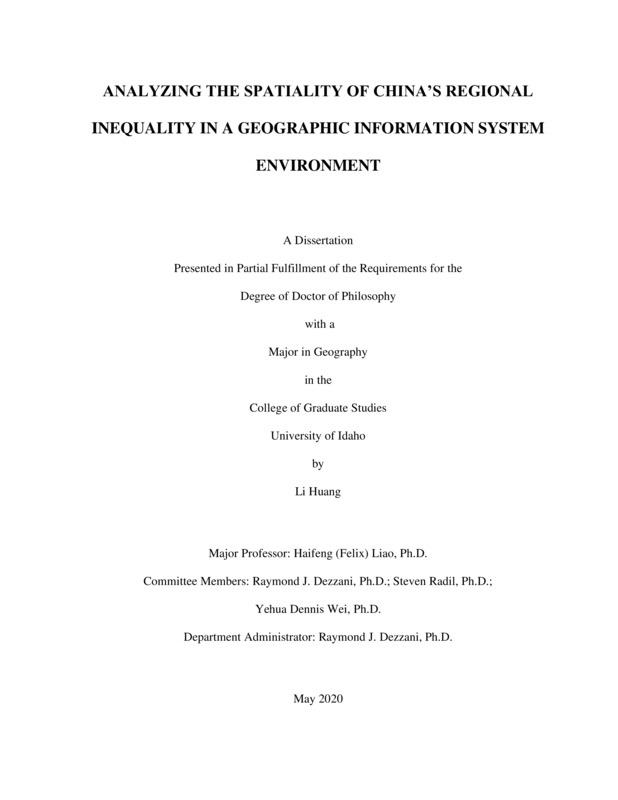ANALYZING THE SPATIALITY OF CHINA’S REGIONAL INEQUALITY IN A GEOGRAPHIC INFORMATION SYSTEM ENVIRONMENT
Huang, Li. (2020-05). ANALYZING THE SPATIALITY OF CHINA’S REGIONAL INEQUALITY IN A GEOGRAPHIC INFORMATION SYSTEM ENVIRONMENT. Theses and Dissertations Collection, University of Idaho Library Digital Collections. https://www.lib.uidaho.edu/digital/etd/items/huang_idaho_0089e_11748.html
- Title:
- ANALYZING THE SPATIALITY OF CHINA’S REGIONAL INEQUALITY IN A GEOGRAPHIC INFORMATION SYSTEM ENVIRONMENT
- Author:
- Huang, Li
- ORCID:
- 0000-0003-1084-3346
- Date:
- 2020-05
- Keywords:
- China GIS regional development regional inequality spatiality
- Program:
- Geography
- Subject Category:
- Geography; Economics; Geographic information science and geodesy
- Abstract:
-
Regional inequality is an essential topic in academic inquiry and policy making. With the rapid economic development after the reform and opening-up, the rising inequality in China has drawn considerable attention. While the studies on the spatiality of regional inequality have flourished and renewed the debate, the examination of space, scale, and locality over a long time period or at the finest level is relatively insufficient. Drawn upon a multi-scale and multi-mechanism framework, this dissertation aims to fill the gap by investigating regional inequality in China for the last sixty years and the patterns and mechanisms based on the county level data.
The first empiric chapter focuses on the long-term pattern of regional inequality and how spatially heterogeneous development processes and policy shocks impact the convergence in China. The findings indicate that the launch of reforms and the entry of WTO have led to the unbalanced redistribution of wealth towards the coastal provinces. While a significant convergence is observed for the eastern and northeastern regions, a divergence trend exists in the central and western regions. The impacts of the transitional processes like globalization, decentralization, and marketization are the most evident in coastal China, and their effects decline or become insignificant in interior China.
The second empiric chapter adopts the finest county level data and investigates how each spatial scale contributes to the pattern and affects the mechanisms of regional inequality. The results observe a plateauing pattern of inequality since the mid-2000s, to which the intra-provincial inequality and the inter-regional inequality contribute the most. The convergence trend as a whole could mask the tendencies of divergence in each region at multiple scales. The multilevel modeling of mechanisms at the intra-provincial and intra-prefectural level suggests that the role played by spatial scales could not be neglected. The effects of triple processes, i.e. globalization, decentralization, and marketization, may turn from positive to negative or vice versa when inequality at different scales is investigated.
The third empiric chapter conducts an in-depth case study of regional inequality in Zhejiang province, a coastal province leading China’s economic growth and reforms. The analyses reveal the importance of local contexts and bottom-up forces in regional development. On the one hand, economic activities are more concentrated due to the Wenzhou model of development and the emergence of new clusters in southern Zhejiang. On the other hand, with the global financial crisis and economic slow-down, the Wenzhou-Taizhou cluster has been challenged by new economic spaces centered on the Hangzhou-Ningbo cluster. The case study suggests the limited efficacy of inequality-reducing policies and the persuasive effects of self-reinforcing agglomeration on economic polarization and income mobility.
In summary, this dissertation comprehensively investigates the spatiality of regional inequality in China. It highlights the role of space, scale, and locality in patterns and mechanisms of regional inequality. Specifically, the spatial heterogeneous development processes, the effects of each spatial scale, and the local context and bottom-up forces are the keys to better understand regional inequality and to further make efficient policies towards balanced regional development.
- Description:
- doctoral, Ph.D., Geography -- University of Idaho - College of Graduate Studies, 2020-05
- Major Professor:
- Liao, Haifeng
- Committee:
- Dezzani, Raymond J.; Radil, Steven; Wei, Yehua Dennis
- Defense Date:
- 2020-05
- Identifier:
- Huang_idaho_0089E_11748
- Type:
- Text
- Format Original:
- Format:
- application/pdf
- Rights:
- In Copyright - Educational Use Permitted. For more information, please contact University of Idaho Library Special Collections and Archives Department at libspec@uidaho.edu.
- Standardized Rights:
- http://rightsstatements.org/vocab/InC-EDU/1.0/

